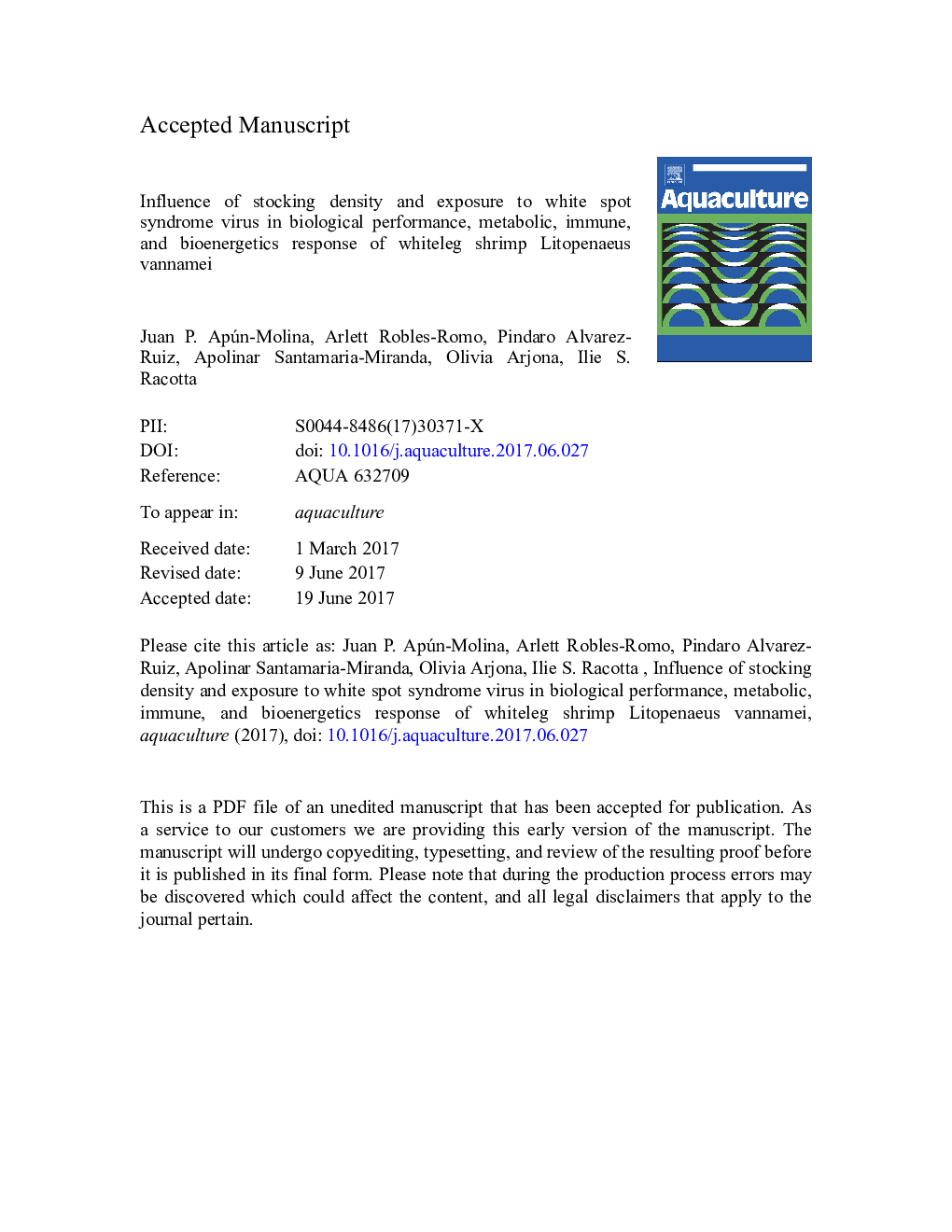| کد مقاله | کد نشریه | سال انتشار | مقاله انگلیسی | نسخه تمام متن |
|---|---|---|---|---|
| 5539275 | 1552809 | 2017 | 57 صفحه PDF | دانلود رایگان |
عنوان انگلیسی مقاله ISI
Influence of stocking density and exposure to white spot syndrome virus in biological performance, metabolic, immune, and bioenergetics response of whiteleg shrimp Litopenaeus vannamei
ترجمه فارسی عنوان
تأثیر تراکم بوته و قرار گرفتن در معرض ویروس سندرم سفید نقطه ای در عملکرد بیولوژیکی، متابولیک، ایمنی و پاسخ بیولوژیکی میگو لیتوپنای حمام
دانلود مقاله + سفارش ترجمه
دانلود مقاله ISI انگلیسی
رایگان برای ایرانیان
کلمات کلیدی
موضوعات مرتبط
علوم زیستی و بیوفناوری
علوم کشاورزی و بیولوژیک
علوم آبزیان
چکیده انگلیسی
The risk of disease in shrimp farming has been suggested to increase with stocking density, although it is not clear if this is related to an increased susceptibility to pathogens based on poor physiological condition or a lower capacity of immune response. This study analyzed the influence of stocking density on the metabolic and immune response to exposure to white spot syndrome virus (WSSV) on whiteleg shrimp Litopenaeus vannamei. Juvenile shrimp were submitted to two stocking densities (20 and 100 shrimp m2) for eight weeks; water quality, growth, and survival were recorded. Then, some shrimp were sampled for determining biochemical composition, adenylic nucleotides, arginine phosphate (Arg-P), total hemocyte count (THC), and clotting time to determine baseline values. Other shrimp were challenged with WSSV for 24Â h and then analyzed for the same variables. Concentration of nitrogenous compounds and phosphorus were significantly higher in tanks with the higher shrimp density. Growth and survival were significantly lower by 42% and 18%, respectively, under high density conditions. No outstanding effect of stocking density on biochemical and immunological variables were observed, except for higher levels of hemocyanin in hemolymph and lactate in muscle in shrimp under low density conditions. In contrast, the WSSV challenge induced several metabolic disruptions, including a higher adenylic energy charge (AEC) in the hepatopancreas and higher content of Arg-P in muscle, higher content of triglycerides in hemolymph, hepatopancreas, and muscle, and higher content of glucose, protein, hemocyanin, and cholesterol in hemolymph. These responses correspond an increased energy demand caused by exposure to virus and/or a phase of metabolic depression. Conditions of high stocking apparently do not increase the susceptibility of shrimp to WSSV since no differences were observed in the severity of infection and THC. However clotting time, glucose, lactate and triglycerides were more importantly affected by WSSV in shrimp coming from the high density condition, suggesting a “dual stress” effect that could in turn affect susceptibility to pathogens.
ناشر
Database: Elsevier - ScienceDirect (ساینس دایرکت)
Journal: Aquaculture - Volume 479, 1 October 2017, Pages 528-537
Journal: Aquaculture - Volume 479, 1 October 2017, Pages 528-537
نویسندگان
Juan P. Apún-Molina, Arlett Robles-Romo, Pindaro Alvarez-Ruiz, Apolinar Santamaria-Miranda, Olivia Arjona, Ilie S. Racotta,
